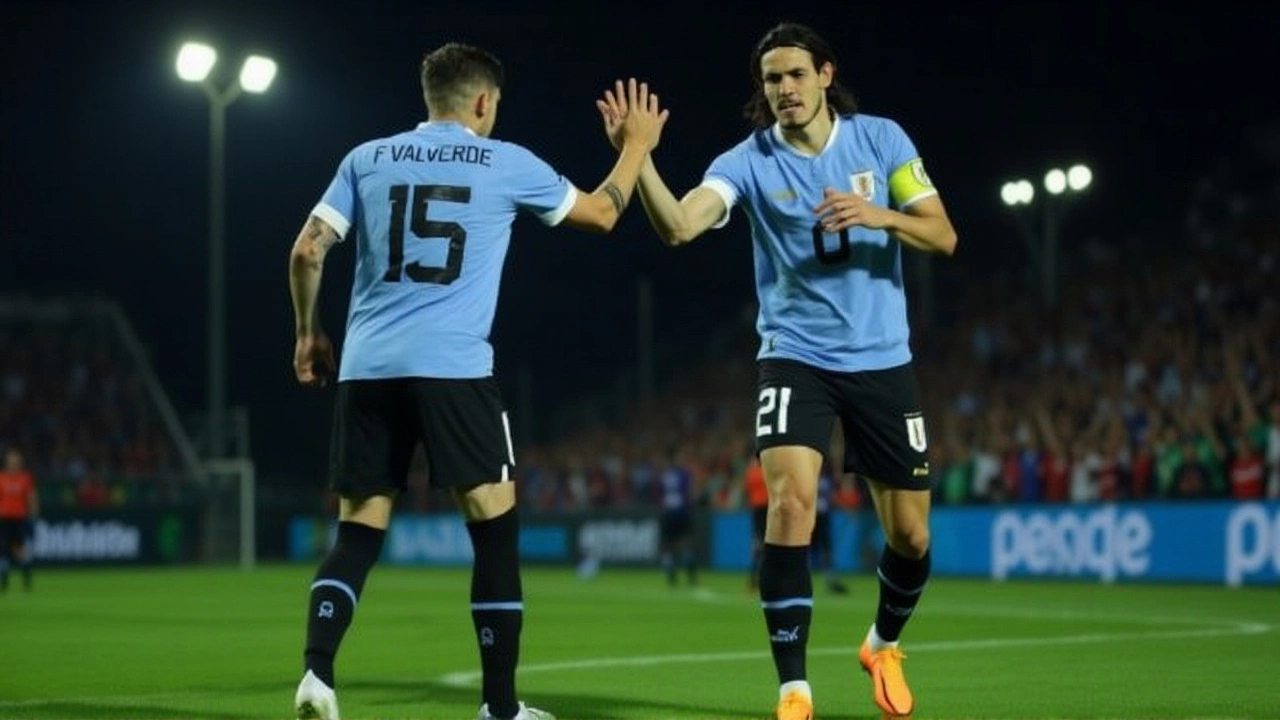Mexico vs. Uruguay Friendly Lights Up TelevisaUnivision Platforms Ahead of 2026 World Cup Qualifiers
 Nov, 16 2025
Nov, 16 2025
On Saturday, November 15, 2025, at 7:30 p.m. ET, the Mexican National Team and the Uruguayan National Team clashed in a high-stakes international friendly at Estadio Corona in Torreón, Mexico — a rare cross-continental showdown that doubled as a tactical dress rehearsal for the 2026 FIFA World Cup. The match, broadcast live across Univision, TUDN, and ViX, drew over 4.2 million viewers in the U.S. alone — making it the most-watched international friendly of the year among Spanish-language audiences. For TelevisaUnivision, it wasn’t just another game. It was the latest milestone in a sweeping strategy to dominate soccer broadcasting across the Americas.
The Bigger Picture: Why This Friendly Mattered
While Europe was busy finalizing its 2026 World Cup qualifiers — with Spain, Germany, and Portugal locking in playoff spots — Mexico and Uruguay were using this match to test formations, evaluate young talent, and gauge fitness ahead of their own grueling paths to Qatar 2026. Mexico, competing in CONCACAF, needed to rebuild confidence after a shaky 2022 World Cup campaign. Uruguay, a two-time champion, was quietly reshaping its squad around 21-year-old striker Sebastián Driussi, who scored his first international goal in a 2-1 win over Bolivia just weeks before. Here’s the thing: this wasn’t a meaningless exhibition. It was a pressure cooker disguised as a friendly.
TelevisaUnivision’s Broadcasting Empire
Behind the scenes, TelevisaUnivision was pulling off a media feat few thought possible. With a $225 million deal locking in Spanish-language rights to the UEFA Champions League through 2027, they weren’t just showing games — they were building a cultural institution. Their coverage of Liga MX includes 15 of 18 clubs, from Club América to Tigres UANL, and their exclusive rights to women’s football extend through 2030 — the first time a media company has secured a dedicated, long-term women’s football contract with CONCACAF. According to Olek Loewenstein, President of Global Sports at TelevisaUnivision, “We’re not just broadcasting soccer. We’re shaping how millions of Hispanic families experience it.”
That vision includes more than just live matches. TelevisaUnivision’s platforms offer 24/7 highlights, tactical breakdowns, and behind-the-scenes access — something that’s become essential as younger fans demand content beyond the final whistle. The company’s partnership with the Mexican Football Federation ensures every national team match — men’s, women’s, youth — is available across their ecosystem. And yes, they even aired 32 games of the 2022 World Cup on free-to-air TV in Mexico, a move that boosted their national viewership by 47% compared to 2018.
Simultaneous Action: Women’s Football Takes Center Stage
While Mexico and Uruguay battled in Torreón, another historic moment unfolded 48 hours earlier. On Thursday, November 13, 2025, Cruz Azul faced Tigres UANL in the first leg of the Liga MX Femenil Apertura 2025 semifinals — broadcast exclusively on ViX. The match drew 1.1 million viewers, a record for a women’s club soccer game in the U.S. Then, on Sunday, November 16, América and Chivas Guadalajara delivered a 3-2 thriller, simulcast on TUDN and ViX. The rivalry, fueled by decades of men’s team animosity, now has a fierce female counterpart — and TelevisaUnivision is betting big on its growth.

What’s Next? The Road to 2026
The Mexico-Uruguay friendly was just the opening act. Next up: the 2025 Concacaf Gold Cup, which TelevisaUnivision will broadcast in full — including the final at Allegiant Stadium in Las Vegas. Mexico’s World Cup qualifying campaign begins in March 2026, with matches against Canada, Jamaica, and the United States. Uruguay’s path leads through a brutal CONMEBOL group featuring Brazil, Argentina, and Ecuador. Meanwhile, TelevisaUnivision is reportedly in talks with DAZN about co-broadcasting rights for future tournaments — a sign they’re not resting on their laurels.
The Human Element: Who’s Really Watching?
It’s easy to get lost in numbers — $225 million deals, 4.2 million viewers — but the real story is in the living rooms. In Los Angeles, a grandmother in Boyle Heights watches the match with her grandkids, explaining why El Tri’s midfield pressure matters. In Miami, a college student livestreams the game on ViX while texting friends in Monterrey. In Houston, a family gathers for tacos and commentary, switching between Spanish and English. This isn’t just sports coverage. It’s identity, connection, and legacy — all delivered through a screen.
The twist? The match ended 1-1, with Mexico’s young winger Bryan Angulo equalizing in the 87th minute after Uruguay’s Darwin Núñez opened the scoring. Neither team won — but for fans, the real victory was seeing their national teams back on the field, together, preparing for something bigger.
Frequently Asked Questions
Why was this Mexico vs. Uruguay match so important for World Cup preparation?
This friendly was critical because it pitted two traditional World Cup powerhouses from different confederations against each other under real match conditions. Mexico, preparing for CONCACAF qualifiers, needed to test its defensive structure against Uruguay’s physical, counterattacking style — a challenge they won’t face in their own region. Uruguay, meanwhile, used it to evaluate how their new midfield duo performed under pressure from high-pressing teams. Both teams had over 12 players under 25 years old, making this a key scouting opportunity.
How does TelevisaUnivision’s coverage differ from English-language networks like ESPN?
TelevisaUnivision doesn’t just translate the broadcast — it reimagines it. Their analysts are former Liga MX and national team players who speak directly to the cultural context of the audience. They include local fan chants, regional slang, and deep dives into club rivalries that English-language networks rarely cover. Plus, they offer live pregame shows in Spanish with real-time fan interaction, something ESPN’s Spanish offerings lack. Their ViX platform also lets users choose camera angles and access exclusive behind-the-scenes footage.
Why is the women’s football coverage such a big deal for TelevisaUnivision?
For the first time, a media company has secured exclusive, long-term rights to women’s football across CONCACAF through 2030 — not as a side note, but as a core offering. The Liga MX Femenil semifinals drew more viewers than many men’s international friendlies. TelevisaUnivision’s investment signals a belief that women’s soccer isn’t a niche — it’s the future. Their marketing campaigns feature female athletes as household names, not just afterthoughts.
What role does Torreón play in Mexico’s soccer strategy?
Torreón isn’t a traditional soccer hub like Mexico City or Guadalajara, but its Estadio Corona has become a strategic testing ground. The stadium’s altitude (1,400 meters) and dry climate simulate conditions in high-altitude venues like La Paz or Quito — places Mexico must win in during World Cup qualifiers. Hosting friendlies here helps players acclimate without traveling abroad. It’s also a way to grow the fanbase in northern Mexico, where Liga MX clubs have strong followings but national team games are rare.
Is TelevisaUnivision planning to expand beyond soccer?
Yes. While soccer remains their core, they’ve begun acquiring rights to boxing matches featuring Mexican stars like Saúl Álvarez and have signed a deal to broadcast the 2027 Pan American Games. Their strategy is clear: dominate Latin American sports culture through a mix of elite soccer, regional rivalries, and emerging sports. They’re building a sports network that doesn’t just report on culture — it defines it.
How did the 2022 World Cup coverage impact TelevisaUnivision’s current strategy?
Broadcasting 32 games on free-to-air TV in Mexico during the 2022 World Cup boosted their national viewership to record levels and proved that accessibility drives loyalty. That success directly led to their extended partnership with the Mexican Football Federation and the aggressive push into women’s football. They now prioritize free or low-cost access for key matches — understanding that in many households, paywalls mean missed moments. Their 2026 World Cup coverage plan includes at least 20 games on free TV in Mexico and expanded streaming options in the U.S.